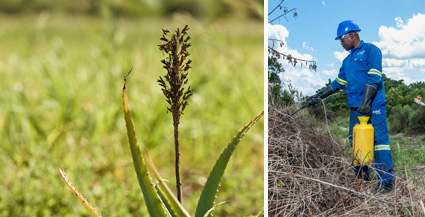
Size and Complexity in Pioneering RehabilitationFor thousands of frogs at Dube TradePort, Friday, 28 February, a national frog awareness day - Leap Day - passed unnoticed. But that’s not to say that nobody is looking out for them. In all, there are at least 23 different species of frogs in the Dube TradePort area, including the critically endangered Pickersgill’s Reed Frog, as well as the vulnerable Spotted Shovel-nosed Frog. According to environmental specialists assisting the Dube TradePort Corporation, the restoration and rehabilitation of 500 hectares of its land probably rates as the largest, most complex undertaking of its kind in KwaZulu-Natal. Further, it has set the ecological bar high with its proactive commitment to land restoration, precinct-wide alien removal and land rehabilitation. “This programme is very complex in terms of its size and range of habitats being rehabilitated or restored. Many of the things being done here have never been done before, so pioneering work is being undertaken,” says David Styles, Specialist Botanist contracted to the project. The programme encompasses three main vegetation-types, including forest and wooded areas, grassland and wetlands. A major focus is restoring grassland. Under Styles’ supervision, alien vegetation is being cleared out, more than 180 different indigenous plant species on the property have been recorded and, with special permission, seed collected and grown in both AgriZone and Tongaat Hulett nurseries is now ready for planting. Indigenous tree planting has been ongoing for 18 months and shortly the major part of the organisation’s Rehabilitation and Restoration Programme - the grassland planting - will start. Dube TradePort Corporation is waiting for a specialised University of KwaZulu-Natal-designed planter, which is being made for the job, to be delivered. There is only one other planter of its kind available in the country, but it is being used in the mining industry. While rehabilitation is an ongoing aspect of environmental compliance, the organisation’s environmental team is being proactive in driving the project and ensuring that extensively more than the bare minimum is achieved. For Jeanne Tarrant, the rehabilitation programme is a blessing for the approximately 2 000 Pickersgill’s Reed Frogs that inhabit the Mt Moreland wetland as invasive alien species threaten the frogs’ natural habitat. “Prior to the Dube TradePort development, the vegetation was poor and degraded as a result of previous farming. While it might be argued that the infrastructure development had detracted from the previous open space, the natural habitat being re-developed is of significantly better quality than that which existed before construction,” says Styles. “This project is so important. Not only will it recreate habitat that once occurred, but will add to the amount of better quality grassland on the KwaZulu-Natal coast, where it has been mostly destroyed and is now endangered.
This project is, therefore, important not only for Dube TradePort, but in a Province-wide context. Dube TradePort Corporation has made a considerable investment in this programme and is following through with these commitments,” maintains Styles. “Birds, in particular the Barn Swallows that use the Mt Moreland wetlands as something of a ‘motel’ for roosting only, are also benefitting from the rehabilitation. Numbers at the roost depend largely on the availability of food. If there is no food the birds will move on to richer areas,” says Angie Wilken, Chairperson of the Mt Moreland Conservancy Committee. Wilken, who has raised the profile of the barn swallows at Mt Moreland and is working with Dube TradePort Corporation on its rehabilitation programme says the clearing of invasive aliens is having a brilliant effect. An increased number of other birds - including several rare birds in isolated numbers - and butterflies have also been appearing on the overall site. All this may be attributed to the development of the airport and surrounding Dube TradePort development providing open spaces/grasses and protection (security fencing around the site). Ultimately, the conservationists would like to see more and may see some of their wishes come true. Dube TradePort has identified areas to rehabilitate off-site, as all Dube TradePort land leads up to the wetlands. A proposal and budget have been submitted for extending the Rehabilitation and Restoration Programme into the Mt Moreland wetland area, home of the endangered frogs, and additional land around Lake Victoria has been purchased for restoration purposes.
|
